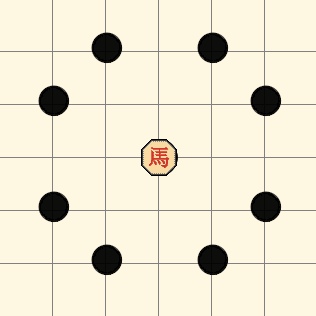Janggi • Korean Chess
Janggi, also called Korean Chess, is played on a 9 x 10 board. It is likely derived directly from Xiangqi, but it is closely related to Xiangqi in any case. Among its unique rules, the king and his two guards cannot leave a 3 x 3 fort.
Rules
- Overall, like Xiangqi with some significant differences.
- The elephant moves like an exaggerated Chinese knight. It moves one step up or down, followed by two steps diagonally.
- The cannon must leap a piece to move and capture.
- The pawn moves and captures one step forward, left, or right.
Pawn
Moves one step to forward or to either side. There is no two-step move from the starting position, unlike the International game. Unlike International chess's pawn, the soldier cannot promote; once reaching the last row, it can only move to the left or right. (Some version of rules do allow promotion, but promotion is not allowed in the rules we've implemented in Distant Armies.)

Guard
Moves and captures one step in any direction. The guard cannot leave the fort.

Horse
Moves and captures by leaping one piece forward followed by one diagonally. This is exactly like the knight International chess except that the horse can be blocked by an intervening piece.

Elephant
The elephant has moves one step orthogonally plus two steps diagonally. The move can be blocked if there is a piece in either of the two intervening positions.

Chariot
Moves any number of positions orthogonally (up or down) and captures the last piece encountered if of the opposing side. If the chariot start from inside a palace, then it can additionally move diagonally inside the palace, like the bishop.

Cannon
Can only move and capture by leaping one intervening piece. Also, it cannot leap or capture a cannon of either side. It can also leap diagonally inside the palace if it start from inside the palace.

General
Moves and captures one step in any direction, but the king cannot leave the palace.

References Cited
Murray, H. J. R. A History of Chess (Northampton, MA: Benjamin Press, 1985)
